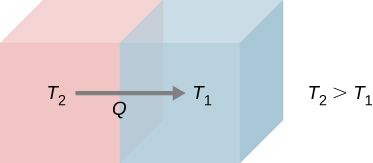| << Chapter < Page | Chapter >> Page > |
From the microscopic point of view, a particle described by Newton’s second law can go backward if we flip the direction of time. But this is not the case, in practical terms, in a macroscopic system with more than particles or molecules, where numerous collisions between these molecules tend to erase any trace of memory of the initial trajectory of each of the particles. For example, we can actually estimate the chance for all the particles in the expanded gas to go back to the original half of the container, but the current age of the universe is still not long enough for it to happen even once.
An irreversible process is what we encounter in reality almost all the time. The system and its environment cannot be restored to their original states at the same time. Because this is what happens in nature, it is also called a natural process. The sign of an irreversible process comes from the finite gradient between the states occurring in the actual process. For example, when heat flows from one object to another, there is a finite temperature difference (gradient) between the two objects. More importantly, at any given moment of the process, the system most likely is not at equilibrium or in a well-defined state. This phenomenon is called irreversibility .
Let us see another example of irreversibility in thermal processes. Consider two objects in thermal contact: one at temperature and the other at temperature , as shown in [link] .

We know from common personal experience that heat flows from a hotter object to a colder one. For example, when we hold a few pieces of ice in our hands, we feel cold because heat has left our hands into the ice. The opposite is true when we hold one end of a metal rod while keeping the other end over a fire. Based on all of the experiments that have been done on spontaneous heat transfer, the following statement summarizes the governing principle:
Heat never flows spontaneously from a colder object to a hotter object.
This statement turns out to be one of several different ways of stating the second law of thermodynamics. The form of this statement is credited to German physicist Rudolf Clausius (1822−1888) and is referred to as the Clausius statement of the second law of thermodynamics . The word “spontaneously” here means no other effort has been made by a third party, or one that is neither the hotter nor colder object. We will introduce some other major statements of the second law and show that they imply each other. In fact, all the different statements of the second law of thermodynamics can be shown to be equivalent, and all lead to the irreversibility of spontaneous heat flow between macroscopic objects of a very large number of molecules or particles.
Both isothermal and adiabatic processes sketched on a pV graph (discussed in The First Law of Thermodynamics ) are reversible in principle because the system is always at an equilibrium state at any point of the processes and can go forward or backward along the given curves. Other idealized processes can be represented by pV curves; [link] summarizes the most common reversible processes.
| Process | Constant Quantity and Resulting Fact |
|---|---|
| Isobaric | Constant pressure |
| Isochoric | Constant volume |
| Isothermal | Constant temperature |
| Adiabatic | No heat transfer |
State an example of a process that occurs in nature that is as close to reversible as it can be.
Some possible solutions are frictionless movement; restrained compression or expansion; energy transfer as heat due to infinitesimal temperature nonuniformity; electric current flow through a zero resistance; restrained chemical reaction; and mixing of two samples of the same substance at the same state.
A tank contains 111.0 g chlorine gas which is at temperature and absolute pressure The temperature of the air outside the tank is . The molar mass of is 70.9 g/mol. (a) What is the volume of the tank? (b) What is the internal energy of the gas? (c) What is the work done by the gas if the temperature and pressure inside the tank drop to and , respectively, due to a leak?
A mole of ideal monatomic gas at and 1.00 atm is warmed up to expand isobarically to triple its volume. How much heat is transferred during the process?
A mole of an ideal gas at pressure 4.00 atm and temperature 298 K expands isothermally to double its volume. What is the work done by the gas?
After a free expansion to quadruple its volume, a mole of ideal diatomic gas is compressed back to its original volume isobarically and then cooled down to its original temperature. What is the minimum heat removed from the gas in the final step to restoring its state?

Notification Switch
Would you like to follow the 'University physics volume 2' conversation and receive update notifications?